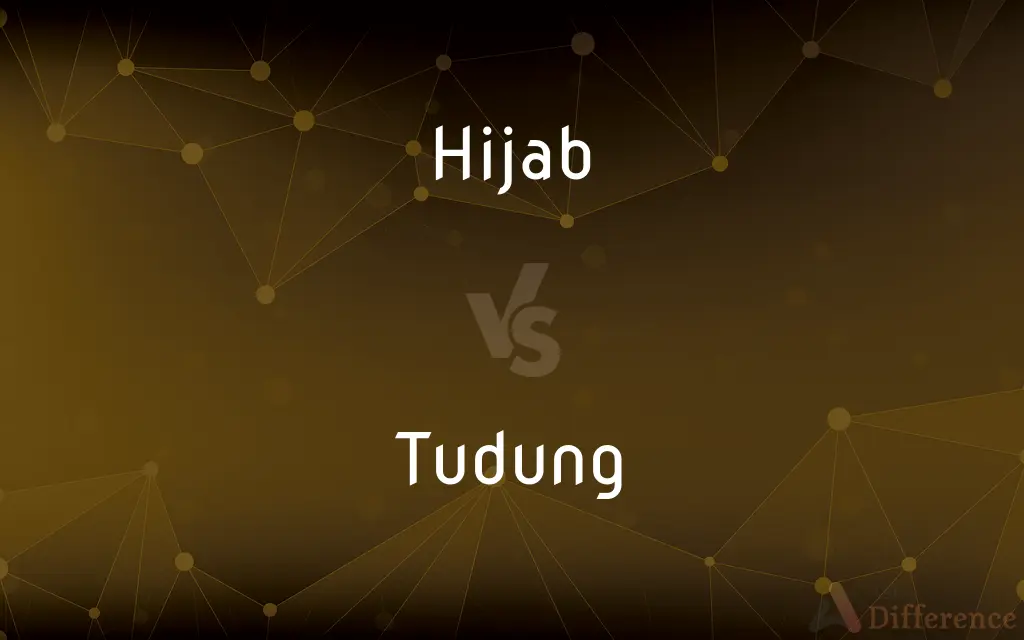Hijab vs. Tudung — What's the Difference?
By Tayyaba Rehman — Updated on May 27, 2024
Hijab is a general term for modest Muslim head covering, while Tudung is the specific Malay term for a type of hijab. Both denote modesty in Islamic culture.

Difference Between Hijab and Tudung
Table of Contents
ADVERTISEMENT
Key Differences
The term "hijab" is rooted in Islamic traditions and is an Arabic word that translates to "veil" or "curtain." Hijab represents both a physical covering and a philosophical concept of modesty in Islam. On the flip side, "tudung" is a Malay term used predominantly in Malaysia, Singapore, and parts of Indonesia. Tudung specifically describes the headscarf that covers the hair, neck, and often the shoulders, but leaves the face clear.
Hijab, being an Arabic term, is widely recognized across various Muslim communities globally. It can represent various types of coverings depending on cultural and personal preferences, from simple headscarves to full-body coverings like the burqa. Tudung, in its essence, is a form of hijab but is culturally specific to the Malay world.
While both hijab and tudung serve the purpose of upholding modesty, their terminology and cultural implications differ. Hijab is more universal in the Muslim world, whereas tudung signifies a regional expression of the broader hijab concept.
Comparison Chart
Definition
General term for modest Muslim covering
Malay term for a type of hijab
Language Origin
Arabic
Malay
ADVERTISEMENT
Cultural Context
Used globally in Muslim communities
Predominantly in Malaysia, Singapore, and parts of Indonesia
Scope
Refers to various types of coverings
Specifically the headscarf covering hair and neck
Representation
Both a physical covering and a concept of modesty
Physical head covering as a regional hijab expression
Compare with Definitions
Hijab
An Islamic principle of modesty extending beyond clothing.
Modesty in actions is also a part of observing hijab.
Tudung
A garment covering the hair, neck, and sometimes shoulders.
Her tudung was draped elegantly, leaving her face clear.
Hijab
A symbol of identity and faith for many Muslim women.
Her hijab was a proud statement of her faith.
Tudung
A Malay headscarf worn by Muslim women.
Her tudung was beautifully embroidered with floral designs.
Hijab
A head covering worn by Muslim women as a sign of modesty.
She wore a hijab to the mosque for prayers.
Tudung
A specific type of hijab common in Malaysia and neighboring regions.
In Malaysia, you'll see many women donning a tudung.
Hijab
A veil or curtain in Arabic terminology.
The room was separated by a hijab, ensuring privacy.
Tudung
A regional interpretation of the broader hijab concept.
While hijab is universal, tudung is its regional variant.
Hijab
A term encompassing various types of Muslim women's coverings.
There are many styles and types of hijabs one can choose from.
Tudung
A cultural expression of modesty in the Malay world.
Wearing a tudung is a cultural tradition in her family.
Hijab
A hijab (; Arabic: حجاب, romanized: ḥijāb, pronounced [ħɪˈdʒaːb] in common English usage) is a religious veil worn by Muslim women in the presence of any male outside of their immediate family, which usually covers the hair, head and chest. The term can refer to any hair, head, face, or body covering worn by Muslim women that conforms to Islamic standards of modesty.
Tudung
A form of the hijab worn in Malaysia
Hijab
Any of several cloth head coverings worn by Muslim women.
Tudung
A scarf worn around the head by Muslim women in Malaysia; conceals the hair but not the face
Hijab
The veiling of women in some Islamic societies, customarily practiced in order to maintain standards of modesty.
Hijab
The practice, among Muslim women, of covering the body after the age of puberty in front of non-related adult males.
Hijab
(countable) A traditional headscarf worn by Muslim women, covering the hair and neck.
Hijab
A headscarf worn by Muslim women; conceals the hair and neck and usually has a face veil that covers the face
Hijab
The custom in some Islamic societies of women dressing modestly outside the home;
She observes the hijab and does not wear tight clothing
Common Curiosities
Does every Muslim woman wear a tudung in Malaysia?
While common, not every Muslim woman in Malaysia chooses to wear a tudung.
Is tudung exclusive to Malaysia?
No, tudung is worn in Malaysia, Singapore, and parts of Indonesia.
What does hijab mean in Arabic?
In Arabic, hijab translates to "veil" or "curtain."
Are there variations in tudung styles?
Yes, there are numerous tudung styles, patterns, and lengths.
How is tudung different from other hijabs?
Tudung is a specific type of hijab native to the Malay world, covering the hair and neck.
Is the concept of hijab limited to clothing?
No, hijab also embodies modest behavior, speech, and demeanor.
Can hijab refer to clothing other than head coverings?
Yes, hijab can refer to various modest coverings, including full-body garments.
Is wearing a hijab mandatory in Islam?
Interpretations vary, but many believe it's a religious obligation for Muslim women.
Share Your Discovery

Previous Comparison
Interest vs. Passion
Next Comparison
Collagen vs. RetinolAuthor Spotlight
Written by
Tayyaba RehmanTayyaba Rehman is a distinguished writer, currently serving as a primary contributor to askdifference.com. As a researcher in semantics and etymology, Tayyaba's passion for the complexity of languages and their distinctions has found a perfect home on the platform. Tayyaba delves into the intricacies of language, distinguishing between commonly confused words and phrases, thereby providing clarity for readers worldwide.













































